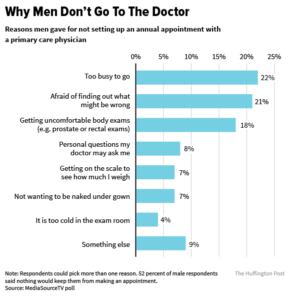7 Marketing Ideas to Draw Men Into Their Doctor’s Office
 There’s a serious gender gap in healthcare marketing. So, in advance of National Men’s Health Week (CDC, June 12-18, 2017), here are some marketing idea-starters—to reach, motivate and encourage men to make health a priority. But be forewarned, men are a tough audience—they are underserved and highly reluctant to see the inside of a doctor’s office.
There’s a serious gender gap in healthcare marketing. So, in advance of National Men’s Health Week (CDC, June 12-18, 2017), here are some marketing idea-starters—to reach, motivate and encourage men to make health a priority. But be forewarned, men are a tough audience—they are underserved and highly reluctant to see the inside of a doctor’s office.
Not so with women. Doctors and hospitals have invented dozens of clever and business-smart ways to appeal to women patients. Women are receptive, for example, to upscale pamper-and-care facilities (that rival luxury spas and salons), and home-like birthing center environments.
These and other posh-and-stylish venues deliver specialized medical services for women that far outdistance the typical clinical environment for men. At best, a male patient would find office environs to be sterile, unremarkable and ordinarily-business-like.
This contrast may not be universally true, it’s safe to say that women actually deserve the better environment. Healthcare marketing professionals have long recognized that women make most medical decisions—they make 80 percent of family health care choices.[Kaiser Foundation]
By far, they are better, more important, and more proactive patients than men. Heck—60 percent of men simply refuse to go to the doctor (except, perhaps, when they fear a serious problem. [Cleveland Clinic]
- 90 percent of women have physicians, but only 62 percent of men have doctors [Men’s Health Network]
- 55 percent of men had not seen a PCP for physical exam in the past year [Study: AAFP]
- 53 percent of men surveyed don’t talk about their health [Cleveland Clinic]
Men didn’t set an appointment with a doctor because they claim they are too busy, afraid of what might be wrong, and/or they are uncomfortable with certain exams or other reasons.

Men: Healthcare’s reluctant and underserved market…
And get this: “Men were more than twice as likely to say they’ve never had contact with a doctor or health professional as an adult. Ever.” [CDC; HuffPost Report] Is it any wonder that American men die anywhere from five years to 10 years younger than women?
Begin by looking at the reasons that men don’t want to go to the doctor, and reverse engineer answers to these issues. Big picture concepts include working through the patient experience, with an emphasis on personal convenience and comfort.
Design facilities with “man cave” comfort. With a tip of the hat to the Advisory Group research firm, physician offices could be a lot more “man friendly” instead of cold and clinical. If a women’s health center can be feminine, a masculine office motif would help put men at ease. Contemporary design might provide personal electronics, wifi, big screens and overstuffed leather furniture.
Convenience is the new currency. Men, in particular, want on-time and unhurried appointments. They appreciate confidential and relaxed meetings with providers. Millennials are particularly sensitive to convenience, comfort and using the Internet.
Why not healthcare in a hardware store? If an urgent care office can meet up with big-box retail shoppers, or a pharmacy/drug store can be at home in a grocery store, why not re-think the opportunity to meet men inside a hardware or sporting goods store?
Take health screenings and services to them. Men may be more willing to “man up” (and see a doctor) when among their men friends. Bring screenings and services to men at work or at sports events. This in addition to civic breakfasts and community events. Men respect and follow leaders. Actively recruit leaders to…well, be leaders.
Turn on the telehealth options. A growing number of patients and providers recognize and appreciate the benefits of telemedicine. The pervasive availability of technology allows for remote doctor (or other professional providers) visits via video consultation or telehealth connection.
Put the fix in with his spouse. Consider marketing and advertising that specifically speaks to the spouse about men’s health issues, problems or solutions. About 80 percent of men in an AAFP survey said their partner/significant other influences their decision to go to the doctor.
Fix those drafty hospital gowns. Nobody likes a hospital stay, even a brief one that includes an encounter with the traditional hospital gown—the open-tail semi-wrap that hasn’t changed in years. In addition to being a drafty indignity, patient surveys put them at the top of the dissatisfaction list. What’s worse, gowns are unnecessary for a large percentage of patients who could be wearing light clothing or pajamas.
What are you doing to reach the most reluctant patients?
Men and men’s health is a vastly underserved market opportunity. As a group, men can benefit from preventive care and an active role in their health. About 4 out of 10 men—the guys who don’t see a doctor and don’t participate in screenings—have some chronic medical problem. Most common are high blood pressure, heart disease, arthritis, cancer or diabetes.
Use these ideas as a creative springboard. How can hospitals, medical groups and providers reach men, the large and reluctant group of patients?








